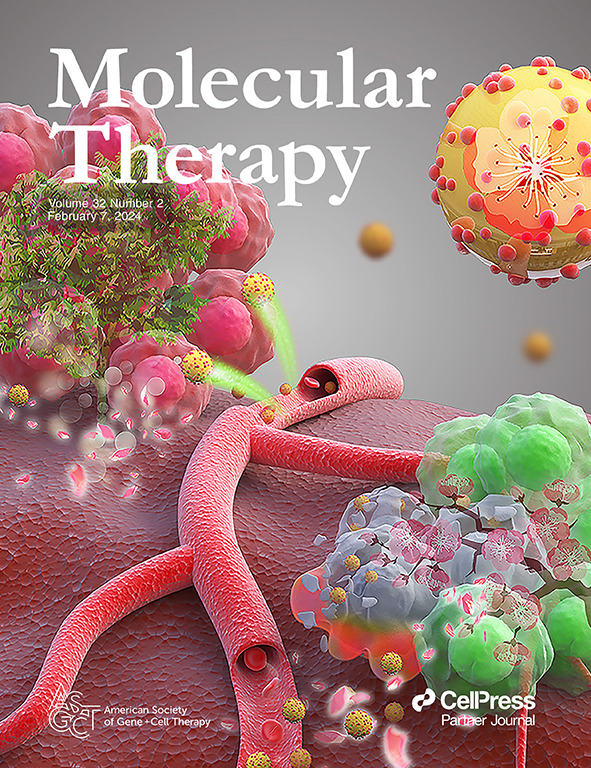miR-375通过调控药物基因表达来预防对乙酰氨基酚诱导的急性肝衰竭。
IF 12.1
1区 医学
Q1 BIOTECHNOLOGY & APPLIED MICROBIOLOGY
引用次数: 0
摘要
对乙酰氨基酚(APAP)过量是急性肝衰竭(ALF)的主要原因,主要是通过过量产生n -乙酰基-对苯醌亚胺(NAPQI)。n -乙酰半胱氨酸(NAC)是fda批准的治疗APAP过量的药物,但人们对microrna作为潜在治疗药物的兴趣越来越大。我们通过嗜肝腺相关病毒血清型8 (AAV8)异位递送miR-375,并在APAP过量诱导的ALF小鼠模型中证明了其有效的保护作用。Slc16a2, Cyb5b和Acsl5被确定为协同作用以减轻毒性的关键靶点。肝脏转录组显示,miR-375过表达或miR-375靶点的沉默增加了小鼠Gstm3的表达。aav8介导的Gstm3表达对APAP-ALF具有保护作用,并且通过破坏Cyp2e1的表达进一步增强了这种保护作用。此外,参与APAP解毒的CYP2E1和GSS分别被miR-375下调和上调。这些发现表明,miR-375通过调控药物基因的表达和谷胱甘肽的合成来阻止APAP-ALF。我们得出结论,miR-375及其靶点是APAP-ALF的有希望的治疗靶点。本文章由计算机程序翻译,如有差异,请以英文原文为准。
miR-375 protects against acetaminophen-induced acute liver failure by orchestrating pharmacogene expression.
Acetaminophen (APAP) overdose is a leading cause of acute liver failure (ALF), primarily through the excessive production of N-acetyl-p-benzoquinone imine (NAPQI). N-acetylcysteine (NAC) is the FDA-approved treatment for APAP overdose, but there is a growing interest in microRNAs as potential therapeutic agents. We delivered miR-375 ectopically via a liver-tropic adeno-associated virus serotype 8 (AAV8) and demonstrated its potent protection in a murine model of APAP overdose-induced ALF. Slc16a2, Cyb5b, and Acsl5 were identified as critical targets acting synergistically to mitigate toxicity. Liver transcriptome revealed that miR-375 overexpression or silencing of the targets of miR-375 increased Gstm3 expression in mice. AAV8-mediated Gstm3 expression protects against APAP-ALF, and the protection was further enhanced by disrupting the expression of Cyp2e1. Additionally, CYP2E1 and GSS, which contribute to APAP detoxification, were down- and upregulated by miR-375, respectively. These findings suggest that miR-375 prevents APAP-ALF by orchestrating the expression of pharmacogenes and enhancing glutathione synthesis. We conclude that miR-375 and its targets are promising therapeutic targets for APAP-ALF.
求助全文
通过发布文献求助,成功后即可免费获取论文全文。
去求助
来源期刊

Molecular Therapy
医学-生物工程与应用微生物
CiteScore
19.20
自引率
3.20%
发文量
357
审稿时长
3 months
期刊介绍:
Molecular Therapy is the leading journal for research in gene transfer, vector development, stem cell manipulation, and therapeutic interventions. It covers a broad spectrum of topics including genetic and acquired disease correction, vaccine development, pre-clinical validation, safety/efficacy studies, and clinical trials. With a focus on advancing genetics, medicine, and biotechnology, Molecular Therapy publishes peer-reviewed research, reviews, and commentaries to showcase the latest advancements in the field. With an impressive impact factor of 12.4 in 2022, it continues to attract top-tier contributions.
 求助内容:
求助内容: 应助结果提醒方式:
应助结果提醒方式:


